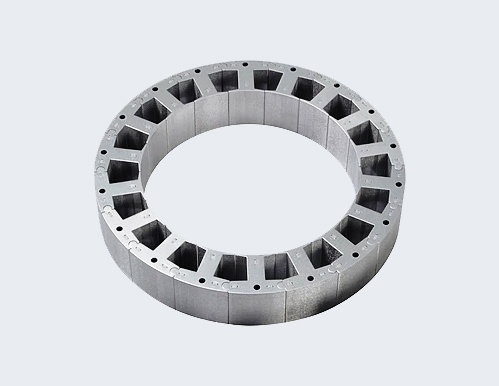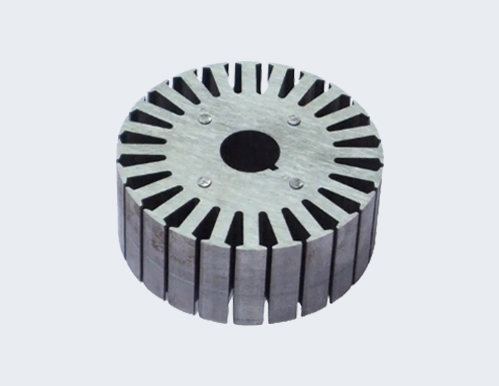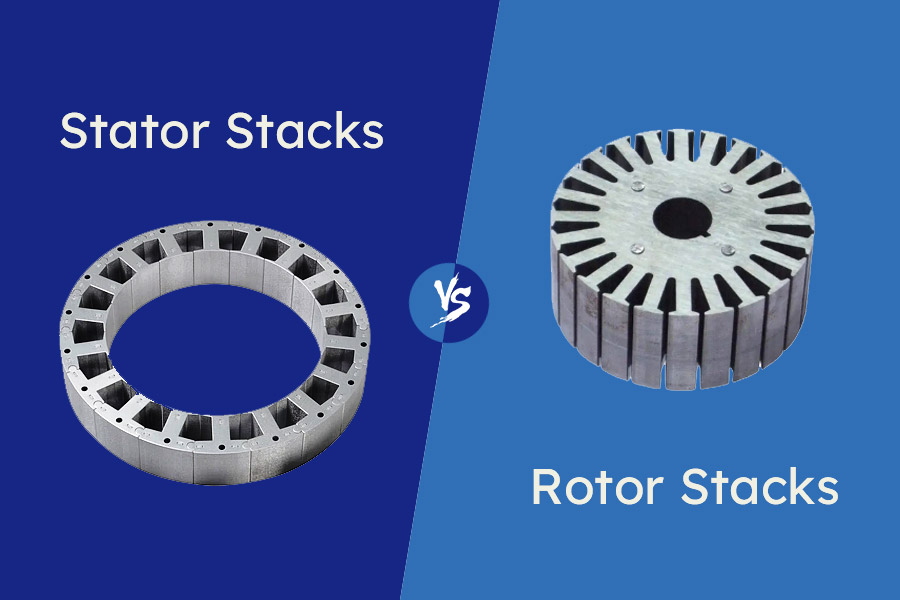The design and performance of electric motors hinge on two fundamental components: stator and rotor lamination stacks. While these components may appear similar, their distinct roles and characteristics create significant differences in how they are engineered and manufactured.
This article provides an in-depth exploration of what sets stator and rotor lamination stacks apart, offering a comprehensive understanding of their unique features, material choices, manufacturing processes, and more.
Introduction to Lamination Stacks
Lamination stacks are assemblies of thin, insulated steel sheets stacked together to reduce energy losses in electric machines. These sheets, often made of silicon steel, are insulated to minimize eddy current losses, thereby enhancing the overall efficiency of electric machines. Both stator and rotor stacks serve critical roles, but their design philosophies and functionalities differ markedly.
Material Choices: Tailored for Purpose

Stator Lamination Stacks:
The primary focus for stator laminations is on magnetic efficiency. They are typically made from high-grade silicon steel, often grain-oriented, to ensure maximum magnetic permeability and reduced hysteresis losses. These laminations receive sophisticated insulating coatings to improve longevity and performance even more.

Rotor Lamination Stacks:
Rotor laminations, on the other hand, prioritize mechanical resilience. They are usually made from non-oriented silicon steel, which provides consistent magnetic properties in all directions. This material choice ensures the rotor’s ability to withstand high-speed rotations and centrifugal forces without compromising efficiency.
Dimensional Differences
The structural differences between stator and rotor stacks are significant and stem from their distinct functions:
- Stator Laminations: These have larger outer diameters and are stationary. Their slots are deeper and specifically designed to house windings, ensuring optimal electromagnetic performance.
- Rotor Laminations: These are smaller in diameter and revolve within the stator. They are engineered for balance and symmetry, with shallow slots designed to channel magnetic flux efficiently.
Manufacturing Processes
Stator Lamination Stacks:
Precision is paramount in the production of stator lamination stacks. Key steps include:
- Stamping: High-speed progressive dies are used to cut thin sheets of silicon steel into the required shapes. The accuracy of the stamping process ensures minimal energy losses.
- Stacking: Laminations are assembled into stacks using interlocking tabs, adhesive bonding, or laser welding.
- Insulation: Coatings such as epoxy or varnish are applied to prevent eddy currents.
Rotor Lamination Stacks:
The manufacturing of rotor stacks is similarly intricate but involves additional steps to account for rotational dynamics:
- Die Casting: Conductive materials such as aluminum or copper are die-casted into the rotor laminations to form bars or other conductive elements.
- Shrink Fitting: Rotor laminations are often press-fitted onto shafts to ensure mechanical stability.
- Balancing: Dynamic balancing processes ensure smooth operation at high speeds, minimizing vibrations and wear.
Magnetic Properties
Laminations’ magnetic qualities are crucial for motor performance:
- Stator Laminations: These are optimized to generate stable magnetic fields, critical for efficient energy conversion.
- Rotor Laminations: These interact dynamically with the stator’s magnetic fields, with designs focused on enhancing torque and minimizing energy losses.
Innovations in Lamination Stack Technology
The environment of lamination stacks has changed due to developments in production techniques and materials:
- Ultra-Thin Laminations: Modern manufacturing techniques allow for the production of thinner laminations, which reduce core losses and improve efficiency.
- High-Speed Stamping: Advanced stamping technologies enhance precision and throughput.
- Laser Welding: This method offers superior structural integrity without compromising magnetic properties.
- Advanced Coatings: New insulating materials provide better thermal management and longer operational lifespans.
Quality Control
Stator and rotor lamination stacks are subjected to rigorous quality control procedures to guarantee optimum performance and dependability:
- Dimensional Inspection: Ensuring tolerances are met to guarantee proper assembly and function.
- Magnetic Testing: Measuring flux density, hysteresis losses, and other magnetic properties.
- Mechanical Testing: Verifying structural integrity and resilience under operational stresses.
Challenges in Production
Despite advancements, manufacturing lamination stacks presents unique challenges:
- Stator Stacks: Precision in slot geometry and alignment is critical to prevent energy losses and mechanical issues.
- Rotor Stacks: Balancing the rotor to ensure smooth rotation and minimizing vibrations requires meticulous attention.
Future Trends in Lamination Stacks
The evolution of electric machine design continues to push the boundaries of lamination stack technology:
- Additive Manufacturing: The potential for 3D printing to revolutionize stack production with customizable designs.
- New Materials: The creation of high-performance coatings and alloys to enhance thermal performance and further minimize losses.
- Automation: Enhanced production lines with robotic assembly and quality inspection to boost efficiency and consistency.
In summary, while stator and rotor lamination stacks share the same foundational purpose of minimizing energy losses, their unique roles demand specialized materials, designs, and manufacturing techniques. By understanding these differences, the industry can continue to innovate and optimize electric motor performance. The journey of refining these critical components will remain central to the advancement of energy-efficient technologies.



